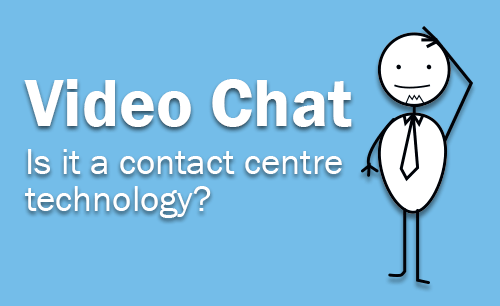Video chat – is it a contact centre technology?

Companies and consumers are increasingly seeing the benefits of implementing live chat. It drives engagement while providing an efficient, fast channel to answer customer queries. Consumers like it as they can engage on chat while still doing other things, making it unobtrusive compared to the telephone or email and fitting in well with their busy lives. The Eptica Multichannel Customer Experience Study found that web chat satisfactorily answered 93.5% of questions asked, and that the average session length was just 4 minutes and 29 seconds. Agents can participate in multiple chats at the same time, increasing efficiency compared to channels such as voice. Consequently more and more organisations are implementing live chat on their websites.
Many commentators and analysts are now looking beyond traditional text, to video-based chat. There are three reasons behind this:
- The technology is mature from both the customer and corporate point of view – almost every PC and mobile device has a built in camera and broadband/3G speeds are able to transmit high resolution moving pictures without undue break up or jitter.
- The rise of video calling through services such as Skype and Facetime means that consumers understand and are comfortable with video as a channel.
- A picture is worth a thousand words. People relate to seeing other people and engage more deeply than through text-based channels.
However, amidst all the talk of video chat I’d argue that it is much more part of the sales process rather than acting as a customer service channel. There are significant cons to go with the pros outlined above:
- One of the advantages of text-based chat is that agents can manage multiple chats at once. Obviously this isn’t possible with video chat, as the agent has to give his or her full attention to the viewer, rather than sharing it amongst multiple chat sessions.
- Staff skills. All agents are ambassadors for your brand, but generally they are not visible to the consumer that they are in contact with. So they can wear what they like and appearance is not an issue. Video chat is different, so you have to be sure that your agents are comfortable with appearing in the flesh and have the skills to engage with consumers through video.
- Most contact centres are busy and noisy places – there’s no way you’d want agents to be taking video calls in the middle of crowded offices. Therefore companies offering video chat may need to set up separate spaces, adding to cost and limiting the numbers of agents that can answer video calls at once.
Where video chat fits really well into the customer journey is during the sales phase. I’ve seen some really strong examples where this works. For example, a large US electronics retailer offered video chat that connected consumers directly to in-store staff. They could then take products from the shelf, unbox them and demonstrate them to the interested consumer, enabling them to view the item from all angles and get a real feel for it. Essentially it provided the in-store experience, without the consumer needing to leave their PC.
Another example is in high end fashion retail. Staff could bring out clothes from the warehouse, enabling customers to virtually examine them, giving advice and feedback to help make a choice.
What is important is that both of these examples are pre-purchase and actively help customers to make a choice and spend money with a particular company in a way that meets their individual needs. They are very valuable parts of the sales process, rather than customer service.
So, from my experience, video chat can be extremely powerful in specific situations – however it shouldn’t be part of your mainstream contact centre activities. It is a specific channel and needs to be handled in a special way, with its own staff and objectives if it is to deliver real benefits to customers and your wider organisation.
What are your views and experiences? I’d welcome feedback and thoughts in the comments section below.







Comments